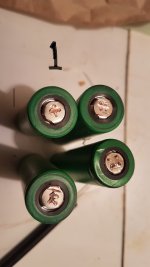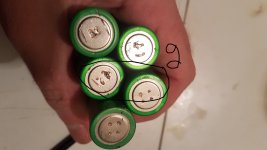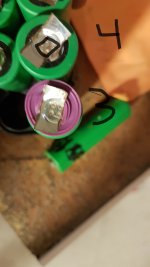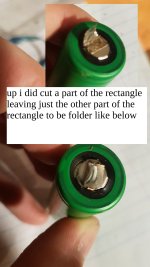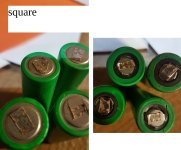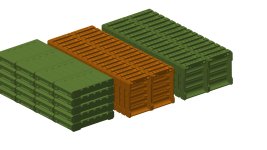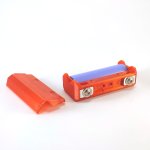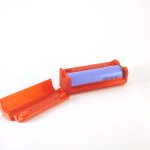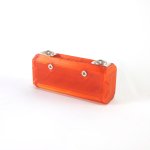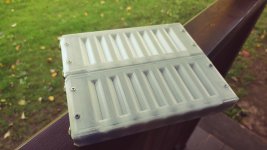sharinginfos
100 W
- Joined
- Sep 1, 2022
- Messages
- 172
Hi everyone, i have those vtc4 that are still good from last mesurement before pandemic.agniusm said:Thank you.
I always strongly advise on using brand new cells from reputable supplier. Pressure design relies on good contact and having cleaned second hand cells does not give you that fully. Its a risk where least you could loose is your property and worst, yours or your families life.
The link you provided is very thin nickel tabs for spotwelding, usually 0.15mm. My tabs are 0.6mm copper. It has bumps and is rigid not to collapse under pressure. Its not possible to make it work. I thought about making it compatible with fuses and its possible but it adds to overall width 13-20mm. Its a substantial amount.
If you use genuine new cells there is very little risk involved to need a fuse. Even medical packs don't have them. To add to this, laptop cells are good to 0.5C. They were not meant for high discharge so 8P would only give you 8A discharge with 2Ah cells safely. It will need 3 x 8P modules to do meaningful currents at the low end.
I used a pair of plier to remove as much metal from them (i started with the bent metal picture)
As you can see on the picture there are some spot where there is still metal.
I read that the nese is tight . i dont know if the tight fit is regarding the diameter of the cell or tight from bottom to top of head.
forgive my spelling mistake im learning english
TO consider: ill build a 13s4p of vtc4.At the moment, all my cells are like the 2 cells identified as no 3 and no 4. Im not good at soldering (and heat damage cells) and spot welding scares me and i read a lot i do find it complicated even if maybe cheaper)i dont want to do that and equip myself with a spot welder for just 2 13s4p. I like the fact that i can remove a bad cell eventually with the nese easily. the motor I will use is a xiongda asking 7 amps. Now i understand that it would have been better to have brand new cell i do understand but i want to work with those cells i have .
Correct me if im wrong but even if i remove the metal left on top as on picture 1 and 2 there will still be elevation from the remaining 4 points .
Is it realistic to dremel those ends flat like new cells???.if yes with what tool and brush.
i will not charge at high amps .
wich of the abcdef options should i go with???
and could all of those fit in the nese module???
i see 6 options
a) fit them with the remaing metal piece attached to at least one spot pict 1 and 2 . How bad would it be if there is only contact from the nese to a tiny bit of metal left? maybe similar to have only one spot weld or less? how bad is it to only have one spot weld contact with nese?
b) to find a way to remove the most metal left leaving the 4 spots wich i beleive is higher than the rest of the nice metal they attach to . seems a lot lot of work to endup with only the 4 spot welds without the metal ontop.
c) would be to add a silicone purple under the rectangle left see cell no 3 ( im kind of affraid the silicone would rupture and a short would happen with the external cell negative enveloppe
d) would be the cut a square just around the 4 spot weld like drawn on cel no 4 (imagine there is just a square left) would that be a flat square surface or not ???? see picture names "care"at the end. it is not so much as a flat square since the native nickel metal ontop makes a valley to the center but still at least one, probably two sides of the square nickel would touch the nese metal part.
maybe it is the best option to choose??? safe enough contact??? ???
e) would be to cut the one of the rectangle side and fold the other end of the rectangle on top of the place where are the 4 spot weld. it is the picture where i wrote a text on white background.
f) would be to fold the rectangle twice on it self adding double of height would the cell plus 4 folds total fit???
risk here would be un even heights of the cells maybe leaving one cell in the middle not presuring the nese
I also see a risk in option E and F in that those folded piece of metal have been folded couple of times and that makes the metal weak wich could endup in riping a part loose and making a short cut.? those folded metal are not so solid and if i need to push the cell hard in the nese ... maybe they wil rip. after testing they can be rather easy to rip since the fold cople times has weaken them.
Iam far from an expert but i beleive that option E would bea good option since it would keep the 4 contact of the spot weld in place and since i would fold only one of the 2 end of the rectangle, there would be a good contact from this folded piece with the nese module. but not so study strong.
Maybe option D would be the best ( it represent more work than option E yes but if you tell me it is the best or the best that would fit in the nese i will do it. hum maybe the square option D would be the best also since the total height of all cells would be similar from one to the other and even if only one side of the square touches the nese it is still a line that represents at least 2 spotwelds minimum
.
Remember i dont want to do something perfect, i want your opinion on wich option i should go with and why.???
With option e that would add one fold on each end... would that fit in the module???
any other thoughs or ideas are welcome .I know you own me nothing, i dont want to pass as feeling entiteled and ordering you to answer me , at the same time i really I feel i would learn if you guys could answer all of the above questions because i m also here to learn and i want to make and informed choice. One of the important thing i would appreciate is what are the downsides or risk i run for each options. i see some but probably miss a couple
I Appreciate it ?


